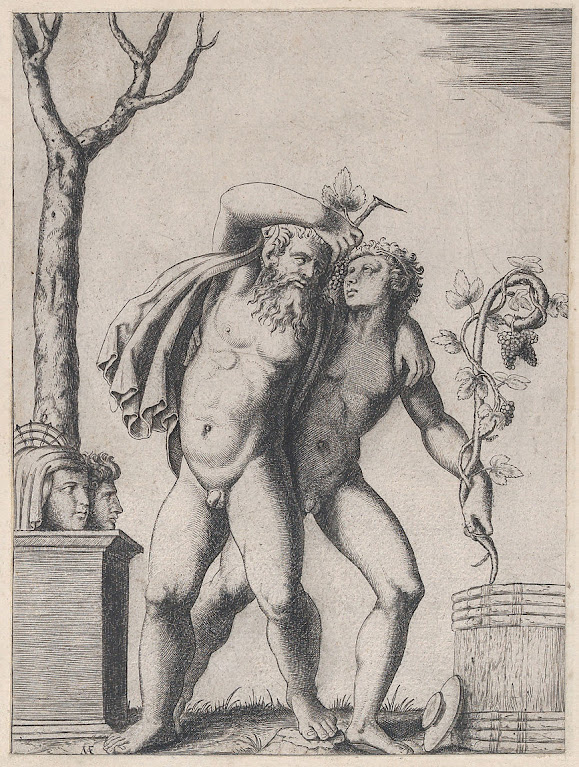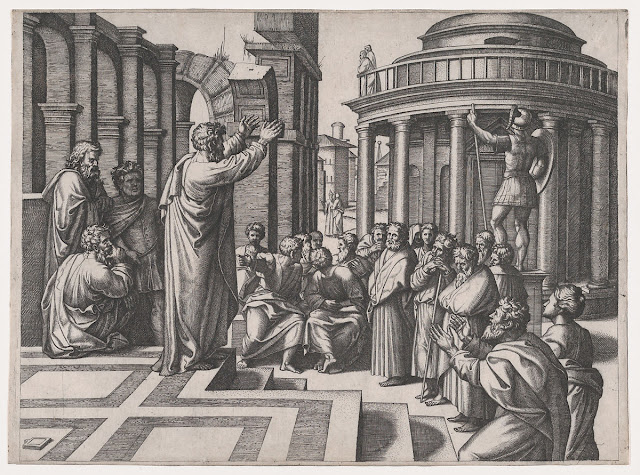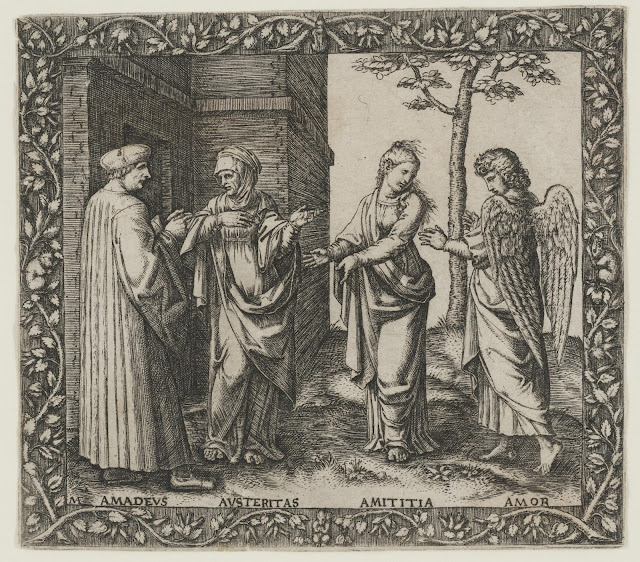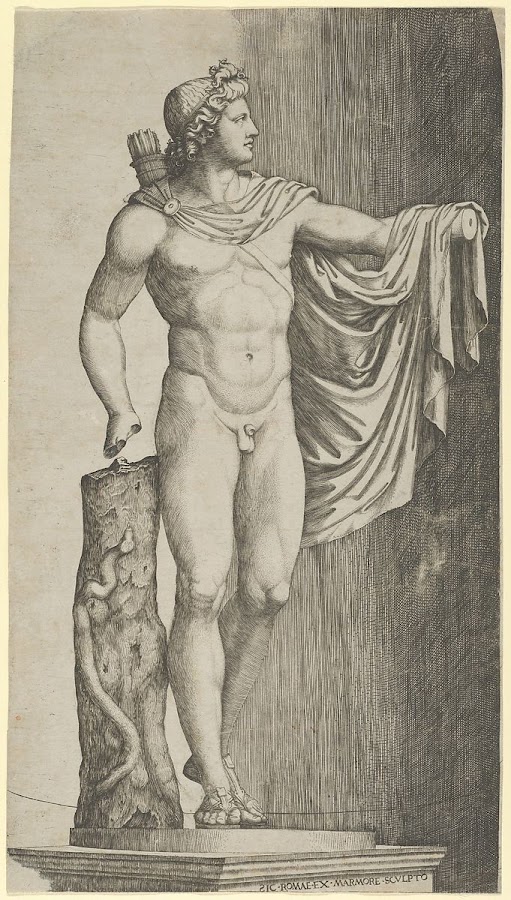An important Renaissance engraver, Raimondi's first prints stem from ca.1500-1505 and show both the influence of Bolognese engravers such as Francia and Lorenzo Costa, as well as Dürer. From ca.1506 - ca. 1508, he was in Venice, making a total of 74 prints after woodcuts by Dürer. During this period, he also made engravings after works by Giorgione and Michelangelo. By ca.1510, Raimondi was in Rome and had befriended Raphael, who included Raimondi's portrait in his Vatican fresco depicting the Expulsion of Heliodorus. From ca.1510-1520, Raimondi, influenced by Raphael, primarily engraved designs by the latter and his followers. His style matured, and featured more fluidity in depicting subjects in motion. Raimondi also collaborated with Baviera on prints that, evidence suggest, were reproduced many times. According to Vasari, the 1527 Sack of Rome left Raimondi destitute. His engravings cannot be accounted for beyond that date.
For more detailed biographical notes see part 1. For earlier works see parts 1 - 3 also.
This is part 4 of 5 parts on the works of Marcantonio Raimondi:
 |
| c1510-1527 Venus and Cupid, possibly after Raphael engraving 17.4 x 13.6 cm Metropolitan Museum of Art, New York |
 |
| c1510-1527 Venus crouching by a plinth on top of which stands Cupid, after Francesco Francia engraving 21.7 x 14.2 cm Metropolitan Museum of Art, New York |
 |
| c1510-1527 Woman with a winged head standing in a niche engraving 8 x 5.2 cm Metropolitan Museum of Art, New York |
 |
| 1510-1530 The Nativity engraving 37.5 x 27.4 cm Museum of Fine Arts, Boston, MA |
 |
| c1510 Dido holding a dagger in her right hand, left arm outstretched, after Raphael engraving 16.1 x 12.8 cm Metropolitan Museum of Art, New York |
 |
| c1510 Apollo engraving 30 x 13.9 cm Fine Arts Museums of San Francisco, CA |
 |
| c1512-1513 The Massacre of the Innocents, after Raphael engraving 28.1 x 43 cm Metropolitan Museum of Art, New York |
 |
| c1512-1514 Adam and Eve flanked by two trees, a town in the background, after Raphael engraving 24.2 x 17.6 cm Metropolitan Museum of Art, New York |
 |
| c1512-1515 A statue of Apollo, after Raphael engraving 22.1 x 10.8 cm Metropolitan Museum of Art, New York |
 |
| c1512-1516 Madonna and Child, after Raphael engraving 24.7 x 16.9 cm Metropolitan Museum of Art, New York |
 |
| c1513-1515 God carried by angels, appearing to Noah and his family, after the Flood, after Raphael engraving 30.6 x 25.1 cm |
 |
| c1513-1515 Two Fauns Carrying a Child engraving 15.8 x 18.3 cm Metropolitan Museum of Art, New York |
 |
| 1513-1518 The Deposition, after Raphael engraving 21.1 x 16.6 cm Rijksmuseum, Amsterdam |
 |
| c1514-1515 The Plague in Crete (“Il Morbetto”), after Raphael engraving on laid paper 19.5 x 24.8 cm Davison Art Centre, Wesleyan University |
1514-1536c Speculum Romanae Magnificentiae: Young and Old Bacchant
This print comes from the museum’s copy of the Speculum Romanae Magnificentiae (The Mirror of Roman Magnificence) The Speculum found its origin in the publishing endeavors of Antonio Salamanca and Antonio Lafreri. During their Roman publishing careers, the two foreign publishers - who worked together between 1553 and 1563 - initiated the production of prints recording art works, architecture and city views related to Antique and Modern Rome. The prints could be bought individually by tourists and collectors, but were also purchased in larger groups which were often bound together in an album. In 1573, Lafreri commissioned a title page for this purpose, which is where the title ‘Speculum Romanae Magnificentiae’ first appears. Lafreri envisioned an ideal arrangement of the prints in 7 different categories, but during his lifetime, never appears to have offered one standard, bound set of prints. Instead, clients composed their own selection from the corpus to be bound, or collected a group of prints over time. When Lafreri died, two-third of the existing copper plates went to the Duchetti family (Claudio and Stefano), while another third was distributed among several publishers. The Duchetti appear to have standardised production, offering a more or less uniform version of the Speculum to their clients. The popularity of the prints also inspired other publishers in Rome to make copies however, and to add new prints to the corpus.
 |
| c1514-1536 Speculum Romanae Magnificentiae: Young and Old Bacchant, after Raphael engraving 17.2 x 13 cm Metropolitan Museum of Art, New York |
 |
| 1515-1516 Galatea standing in a water-chariot pulled by two dolphins, surrounded by tritons, nereids, and putti engraving 40 x 28.7 cm Metropolitan Museum of Art, New York |
 |
| 1515-1516 The Last Supper engraving 28.9 x 43.5 cm Detroit Institute of Arts, MI |
 |
| 1515-1516 Virgin and Child Seated on Clouds, after Raphael engraving 24.6 x 16.7 cm Art Institute of Chicago, IL |
 |
| c1515-1516 A plague scene at right, a man at left holding a torch illuminating part of the scene at left, after Raphael engraving 19.9 x 24.7 cm Metropolitan Museum of Art, New York |
 |
| c1515-1516 David with the head of Goliath, after Raphael etching and engraving 11.1 x 8 cm Metropolitan Museum of Art, New York |
 |
| c1515-1516 Neptune calming the tempest which Aeolus raised against Aeneas' fleet from Book I of the Aeneid, after Raphael engraving 42.3 x 32.4 cm sheet Metropolitan Museum of Art, New York |
 |
| c1515-1516 Satyr and Child engraving 12.3 x 9.5 cm Metropolitan Museum of Art, New York |
 |
| c1515-1516 St Cecilia holding an organ, flanked by St Paul, St John the Evangelist, St Augustine and Mary Magdalen, after Raphael engraving 26.5 x 15.8 cm Metropolitan Museum of Art, New York |
 |
| c1515-1516 The lamentation of the dead Christ, after Raphael engraving, made up with pen and black ink 21 x 16.6 cm Metropolitan Museum of Art, New York |
 |
| 1515-1520 The Judgment of Paris, after Raphael engraving 29.1 x 43.5 cm Art Institute of Chicago, IL |
 |
| 1515-1520 The Judgment of Paris, after Raphael detail |
 |
| 1515-1520 The Judgment of Paris, after Raphael detail |
 |
| c1515-1525 Adam and Eve being expelled from Paradise, after Michelangelo Buonarroti engraving 19 x 14.1 cm Metropolitan Museum of Art, New York |
 |
| c1515-1525 Joseph fleeing from Potiphar's wife, after Raphael engraving 20.7 x 24.1 cm Metropolitan Museum of Art, New York |
 |
| c1515-1525 The Incense Burner, after Raphael engraving 30.2 x 15.2 cm Art Institute of Chicago, IL |
 |
| c1515-1527 Cleopatra lying partly naked on a bed, after Raphael engraving 11.5 x 17.6 cm Metropolitan Museum of Art, New York |
 |
| c1515 Poetry, after Raphael engraving 17.9 x 14.9 cm National Gallery of Art, Washington, DC |
 |
| c1515 Two Fauns Carrying a Child engraving 15.5 x 17.7 cm Fine Arts Museums of San Francisco, CA |
 |
| 1517-1520 Dance of Cupids engraving 11 x 16.6 cm Art Institute of Chicago, IL |
 |
| 1517-1520 Naked man walking to the right carrying a column, after Raphael engraving 21.5 x 14.5 cm Metropolitan Museum of Art, New York |
 |
| 1517-1520 Saint Paul Preaching at Athens, after Raphael engraving 26.3 x 35/7 cm Metropolitan Museum of Art, New York |
1515-1525 The Seven Virtues:
 |
| 1515-1525 Faith personified by a woman engraving 21.8 x 10.8 cm Metropolitan Museum of Art, New York |
 |
| 1515-1525 Fortitude, after Raphael engraving National Gallery of Art, Washington, DC |
 |
| 1515-1525 Prudence, after Raphael engraving National Gallery of Art, Washington, DC |
 |
| 1515-1525 Temperance engraving 22.2 x 10.8 cm National Gallery of Art, Washington, DC |
 |
| c1515-1525 Charity personified by a woman with two children engraving 21.5 x 10.8 cm Metropolitan Museum of Art, New York |
 |
| c1515-1525 Hope engraving Metropolitan Museum of Art, New York |
 |
| c1515-1525 Justice personified by a young woman holding a sword in her raised right hand, scales in her left engraving 21.4 x 10.8 cm Metropolitan Museum of Art, New York |










































